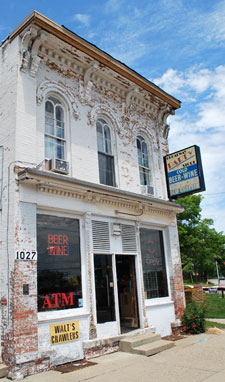Column: More Context for Police Lawsuit
On May 19, 2014, a lawsuit was filed in federal district court against the city of Ann Arbor and three Ann Arbor police detectives who were working to solve an armed robbery that took place about two years earlier – on April 9, 2012. The plaintiff in the federal lawsuit is Joseph Bailey, who was a suspect arrested by the AAPD for the Broadway Party Store robbery.

The Broadway Party Store, on the east side of the Broadway bridges, was robbed in April 2012. The suspect arrested for the crime, but not prosecuted for it, has filed a lawsuit against the three Ann Arbor detectives who worked the case.
It was a high-profile case, as the security camera’s footage from the robbery was featured on Detroit TV news. The video captured the drama of a man wearing a skeleton mask, pointing a sawed-off shotgun at the store owner.
Bailey was charged with the robbery: After a preliminary examination conducted by judge Christopher Easthope at the 15th District Court, Bailey was bound over to stand trial in the 22nd Circuit Court before judge Melinda Morris.
From the time of his arrest at the end of May 2012, Bailey spent roughly 6 months in jail, before being released in November 2012. He wound up not being prosecuted for the robbery, because the prosecutor’s office concluded that Bailey’s guilt could not be established beyond a reasonable doubt at that time. Bailey did plead guilty to resisting or obstructing a police officer. And for that Morris sentenced him to 6 months in jail. Court records indicate that Bailey was already credited with serving 191 days – more than 6 months.
The federal lawsuit was filed nearly three weeks ago, but apparently still has not been served upon the city or the three detectives. It alleges various violations of Bailey’s basic rights by the detectives who worked the case, and contends that their actions caused him to be falsely imprisoned. [.pdf of complaint]
The Chronicle does not systematically cover crime or the courts. But we do occasionally write about those topics when they intersect with our other regular coverage of governmental units.
In this instance, the first point of intersection came in the course of looking up information on Bob Dascola’s election lawsuit. The ruling on Dascola’s case was filed in the federal court’s PACER (Public Access to Court Electronic Records) system on May 20, 2014. We don’t always look up cases on PACER in a way that is most efficient as measured by the number of steps – which would be to note the case number and enter that information into the search form. If you instead search by cases in which Ann Arbor is a defendant, you have a chance to notice cases other than the one you’re looking up. So it was that we noticed Bailey had filed a case in federal court against the city on May 19.
The second point of intersection is that we’d reported the public commentary of the robbery victim at the city council’s May 21, 2012 meeting. And we’d also reported the city administrator’s public congratulation of the police department at the council’s subsequent meeting, on June 4, 2012 meeting – for making an arrest in the Broadway Party Store robbery.
Finally, given that Bailey’s lawsuit has been filed as a public document in the federal court system, we think it would serve the public interest to add context to some of the allegations included in the complaint.
The context added below is also drawn from public documents – court records (obtained through a standard in-person request) and police records (obtained through a Freedom of Information Act request). First, we present a summary of some issues that the two sides could dispute – if the case is litigated. After that a timeline of events is provided. [Full Story]






